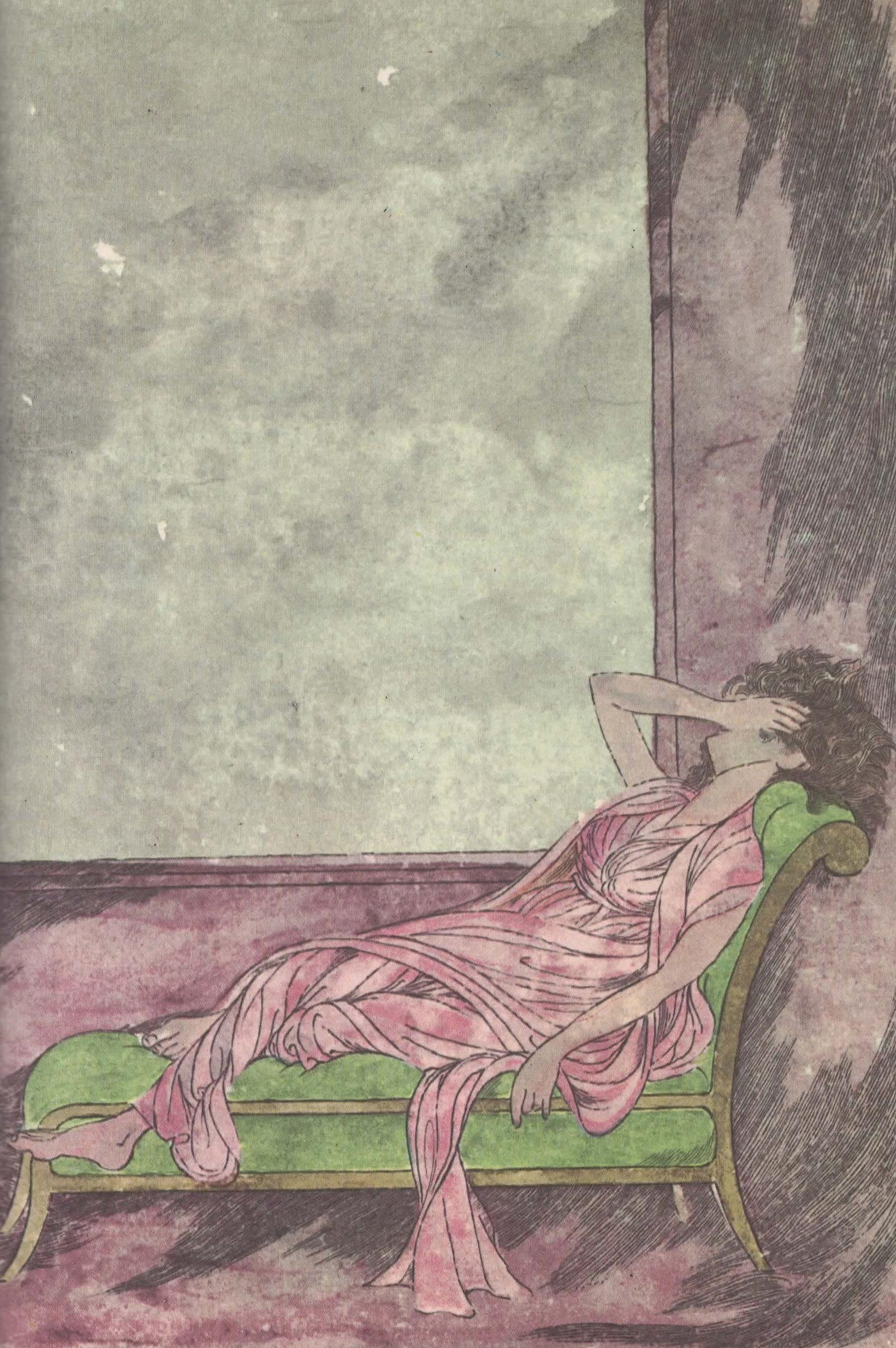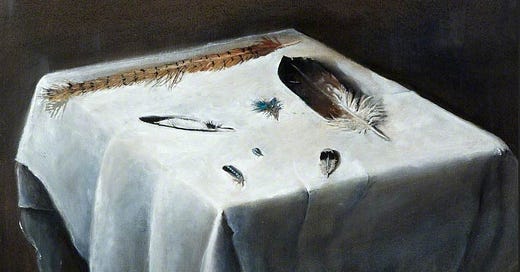Studying Wuthering Heights closely, I’ve been delighted to see my ancestors practiced many of the same superstitions as the rustic inhabitants of the Heights.
Souls and their comings-and-goings fascinate me…so, let’s talk about Catherine Earnshaw.
Catherine Earnshaw is one-half of Catherine & Heathcliff. She is not to be confused with her daughter, also named Catherine. Catherine Earnshaw becomes Catherine Linton and Catherine Linton becomes Catherine Heathcliff. Confusing, I know.1
Whilst reading this essay, you need only remember that although Catherine Earnshaw loves Heathcliff, in this particular episode she is married to Edgar Linton.
‘Feverish Bewilderment’
As readers finish Chapter XI we are thinking Catherine must be the most dramatic woman to ever grace the pages of a novel. She decides—after learning her husband and the man she (actually) loves will never be friends—to break both their hearts by “breaking her own.”
She “lay dashing her head against the arm of the sofa, and grinding her teeth…” and eventually she seizes and stretches out stiff, her eyes roll back into her head and she assumes the aspect of death.

After Catherine’s fit she locks herself in her chamber and refuses food for three days. On the third day she requests water and gruel and once nourished, resumes her wild, narcissistic behavior.2
How strange! she wails, I thought, though everybody hated and despised each other, they could not avoid loving me—and they have all turned to enemies in a few hours.
The narrator in this chapter is Ellen “Nelly” Dean. Nelly is sharing this episode with Mr. Lockwood—tenant at the Grange—to illuminate, in many ways, the personalities of the whole range of characters: Edgar Linton, Isabella Linton, Catherine (Earnshaw) Linton, and Heathcliff.
Nelly describes how Catherine, increasing her feverish bewilderment to madness, and at the height of her frenzy, tore a pillow with her teeth! Yet within one minute, Cathy becomes obstinate and seems, “to find childish diversion in pulling feathers from the [holes] she had just made, [arranging] them on the sheet according to their different species.” Nelly explains, “Her mind had strayed to other associations.”
‘No Wonder I Couldn’t Die!’
To what other associations might Catherine’s mind have strayed? As readers we see a distressed, heartbroken woman pulling feathers from a feather pillow. Brontë makes the point to tell us Catherine is ‘ranging’ them according to their species. Emily Jane knows her flora and fauna, so this is especially interesting:
“That’s a turkey’s,” she murmured to herself; “and this is a wild-duck’s; and this is a pigeon’s. Ah, they put pigeons’ feathers in the pillows—no wonder I couldn’t die! Let me take care to throw it on the floor when I lie down. And here is a moor cock’s; and this—I should know it among a thousand—it’s a lapwing’s. Bonny bird; wheeling over our heads in the middle of the moor. It wanted to get to its nest, for the clouds touched the swells, and it felt rain coming. This feather was picked up from the heath, the bird was not shot; we saw its nest in the winter, full of little skeletons. Heathcliff set a trap over it, and the old ones dare not come. I made him promise he’d never shoot a lapwing after that, and he didn’t. Yes, here are more! Did he shoot my lapwings, Nelly? Are they red, any of them? Let me look.”3
A number of associations are being made in the passage. Catherine has torn a hole in her pillow and has plucked feathers from it—she identifies a feather from a turkey, a wild (non-domesticated) duck, a pigeon, a moor cock, and a lapwing.
Ah, they put pigeons’ feathers in the pillows—no wonder I couldn’t die!
Let me take care to throw it on the floor when I lie down.
What a curious thing to say, no? Readers might wonder why Catherine is distressed to find pigeons’ feathers among the stuffing of her pillow. ‘No wonder I couldn’t die!” she exclaims, and we are made aware of her sincere desire to leave this world.
But, why are pigeons’ feathers inside her pillow to blame for delaying her demise?
Superstitious people (I count myself among such rustics) have long thought pigeons’ feathers in a pillow retard death. Placed among filling in the pillow of a sick person, they delay death only long enough for a far-flung relative to make an appearance to bid farewell to the soon-to-be deceased.
Richard Blakeborough wrote, in his Wit, character, folklore & customs of the North Riding of Yorkshire (1898):
The soul cannot free itself if the dying person has been laid on a bed containing pigeon feathers, or the feathers of wild birds even. Instances are on record of pigeon feathers having been placed in a small bag, and thrust under dying persons to hold them back, until the arrival of some loved one ; but the meeting having taken place, the feathers were withdrawn, and death allowed to enter.
In the case of Catherine, she believes removing the utilitarian-filling (pigeon feathers) will hasten her death—effectively, breaking both Edgar’s and Heathcliff’s hearts.
Why pigeon feathers, I wonder?
Pigeons and doves tend to be interchangeable in literature. The rock dove (Columba livia)—wild ancestor to modern feral pigeons—seems a likely candidate for the pigeon whose feathers Catherine believes are responsible for her continuing anguish.
Doves & pigeons have long been associated with myth, folklore, omen and divination. I’ve written about the symbolism assigned to these birds in the past—so I won’t go on and on—but, suffice to say, it is likely the pigeon’s navigational ability (think: homing pigeon) which encourages a ‘connection to house and home.’
Doves symbolize the spirit and are believed to escort the souls of the dead to Heaven, according to many cultures. Pigeons are stubborn, determined creatures; when they are chased away they often return. These associations are likely to have informed the beliefs of rural people familiar with the birds. Preserving bundles of feathers of doves and pigeons and placing them close to a dying person—the spirit or soul of the loved one may also be preserved here on earth (as opposed to being carried away to Heaven).
‘Don’t you see that face?’
As we emerge from this strange episode with the feathers, Catherine disturbs us (and our unreliable narrator, Nelly) further, by describing the black press she sees across the room. A press is a cupboard (imagine: a wardrobe), and Catherine had one in her room at Wuthering Heights; she does not have one in her chamber at the Grange.
Catherine describes the press in her attempt to convince Nelly she is in fact well; not wandering in her thoughts. She has likened her bed to the fairy cave under Peniston Crag and imagines Nelly collecting elf-bolts…now, she envisions a press!
It does appear odd—I see a face in it! — Don’t you see that face?
She is neither in a fairy cave, Nelly is not collecting elf-bolts. And that face—it is not a ghost. Catherine has caught her own reflection in the mirror. When a frustrated Nelly covers the mirror with a shawl Catherine is further afraid, believing the apparition remains behind it. Why might Brontë included this strange scene?
My own Pennsylvania German ancestors believed mirrors should be covered at the time of death, “or there will be another funeral.” Essentially, a mirroring of the death.
Nelly insists to Catherine that she is neither at the Heights nor has she seen someone else in a black press; the image is a reflection of herself. Is Emily Brontë foretelling a death—wild and free Miss Cathy Earnshaw no longer exists, perhaps the grown-up, married Mrs. Catherine Linton will perish as well?
‘Open the window again wide…’
Janet Gezari tells us in The Annotated Wuthering Heights, “In Yorkshire folklore, doors and windows are opened at the moment of death and mirrors are covered.”
Richard Blakeborough concurs:
When the signs of death are observed the windows and door are thrown wide open, and a silence as still as death itself is maintained, so that nothing shall either hinder the dark angel from setting his seal on [the] loved one, or impede the soul's flight over the borderland into that of the great unknown.
Do you remember me writing about Pennsylvania German seelenfenster (soul windows) in my essay, Conjuring Up Ghosts? Seelenfenster, small windows built into houses for the escape of a recently deceased person’s soul, were built into homes here in rural Pennsylvania.
“Souls are tied to places they have loved,” according to Pennsylvania State University professor, Yvonne Milspaw. If Catherine’s soul is tied to places she loves, she wishes the window to be unhasped. The Grange—and being Mrs. Linton—is not her idea of heaven. If her soul is going to go home, it must return to the Heights.
Oh, I’m burning! I wish I were out of doors—I wish I were a girl again, half savage, and hardy, and free; and laughing at injuries, not maddening under them! Why am I so changed? why does my blood rush into a hell of tumult at a few words? I’m sure I should be myself were I once among the heather on those hills? Open the window again wide wide, fasten it open! Quick, why don’t you move?
Nelly, of course, dissuades the opening of a window. It is mid-January, under a new moon. Remarking, “I won’t give you your death of a cold,” Nelly believes Catherine will calm down. Instead, she laments, You won’t give me a chance at life, you mean.
Do you remember Catherine’s dream—the one in which “angels were so angry they flung [her] out into the middle of the heath on the top of Wuthering Heights?”
What did Catherine do—”[she] woke sobbing for joy.” Heaven is not biblical Heaven for Catherine; heaven is the moors, the heath, and Heathcliff.4
Emily Jane Brontë was only twenty-seven-years-old when she was writing Wuthering Heights. She had experienced illness, suffering and death from the time she was three-years-old. And Emily Jane had formed very specific opinions regarding medicine and heaven/Heaven. Her death has been described as ‘eager’ and, ‘willful.’ And it is widely known she was heart-broken when she died, grieving the recent death of her brother, Branwell.
…the matrix of Wuthering Heights is a return to the intense and absorbing feelings of childhood and adolescence. (Edward Chitham, A Life of Emily Bronte, 2010)
I can’t help but imagine Catherine’s vision of heaven is not unlike what Emily Jane envisioned. She adored nature, was always looking out of windows, rambling on the moors, wild, free and unsupervised.
My 1970s childhood!—switching out Yorkshire moorland for the fields & forests of Pennsylvania. Heaven should be all these things. Don’t you agree?
I am compiling a detailed Character list to be published soon. You’re welcome.
See: Volume I, Chapter XII (1784)
Analysis of the nest of skeletons and the lapwings I will save for another essay.
See: Volume I, Chapter IX (1780-1783)
Cover Image: Seven Different Feathers on a White Tablecloth, date unknown, J. Ree | Cardiff Royal Infirmary







Wonderful analysis yet again, thank you so much